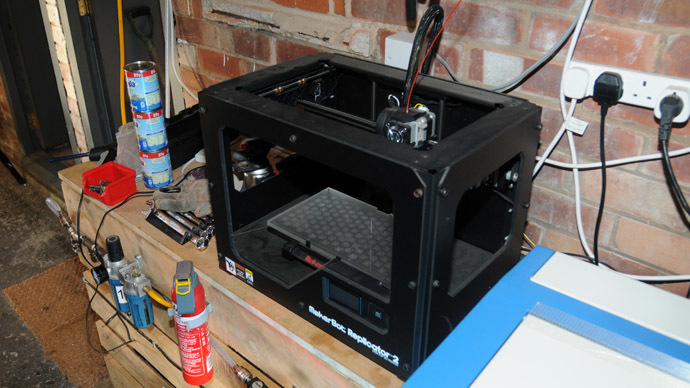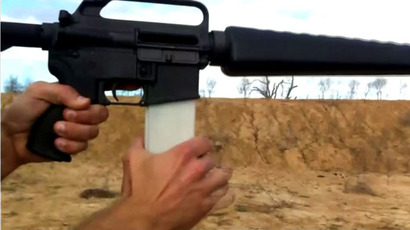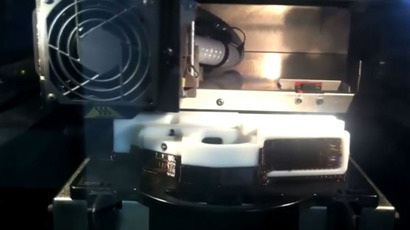Lock, stock and a smoking printer? UK police seize ‘3D-printed gun parts’

British police say they’ve seized a 3D printer and 3D-printed gun components, including a trigger and a magazine capable of holding bullets, during a raid in Manchester. Critics, however, say they found nothing more than spare printer parts.
The alleged gun parts were discovered, along with the 3D printer,
when officers from the Greater Manchester Police force carried
out a search Thursday in the Baguley area of Wythenshawe, in the
south of Manchester.
If the parts prove to be legitimate, the bust would represent the
first-ever seizure of the next-generation weapon, which can be
constructed by a 3D printer almost entirely out of plastic –
creating the possibility of evading detection by airport security
metal detectors.
The components are now being forensically examined by firearms
specialists to establish if they could be used to construct a
functional device.
A man has been arrested on suspicion of making gunpowder and is
currently in custody for questioning.
Police fear such weapons can be created by criminals in the
privacy of their own homes, thus evading detection by security
scanners at airports and other high-risk targets.
“If what we have seized is proven to be viable, components
capable of constructing a genuine firearm, then it demonstrates
that organized crime groups are acquiring technology that can be
bought on the high street to produce the next generation of
weapons,” Greater Manchester Detective Inspector Chris Mossop
told Sky News.
“In theory, the technology essentially allows offenders to
produce their own guns in the privacy of their own home, which
they can then supply to the criminal gangs who are causing such
misery in our communities,” he said. “Because they are also
plastic and can avoid X-ray detection, it makes them easy to
conceal and smuggle. These could be the next generation of
firearms.”
A commenter on the California tech-blog GigaOM noted, however,
that the parts being paraded in the media “are actually spare
parts for a 3D printer,” and not components for a weapon.
“If the police thinks that the part on the photo is a trigger,
just search mk8 on thingiverse.com and you will see that it’s a
upgrade part for a printer. I really don’t get this media/police
fascination relating to 3d printers with guns… it’s a tool to
make 3d parts, not guns,” user nuno gato wrote.

Hours later, New Scientist came to the same conclusion, noting
the "trigger" identified by police appears to be part of a
MakerBot 3D printer designed to extrude 3D-printing plastic to
make an object. The "clip," incidentally, looks like a part
intended to hold spools of plastic.
"It does look like the MakerBot part," Stuart Offer, of
3D-printing firm 3T RPD in the UK city of Newbury, told the
magazine. "These 3D printed guns seem to have hit the headlines,
but I've no idea why they take off so much," he said, noting
that homemade weapons were not that difficult to manufacture.
"A little engineer in his shed with a mill down the bottom of
the garden could make a proper metal barrel capable of firing a
high-velocity bullet."

3D printed weapons first came to the attention of law enforcement
officials worldwide after Defense Distributed announced it had
successfully test-fired a handgun created with a 3D printer.
In May, the organization, founded by a 25-year-old
crypto-anarchist Cody Wilson, posted blueprints for the
single-shot .380-caliber Liberator online.
The files were downloaded more than 100,000 times in just two
days before the US State Department demanded that they be
removed. Britain was the No. 5 downloader of the plans upon
publication, with Germany, Brazil, the United States and Spain
filling out the top four positions.
A working version of the Liberator went on display in September
in the Victoria and Albert Museum in London.
The only non-plastic part of the Liberator is a tiny nail that
acts as the firing pin, as well as a .380 cartridge it fires.
Wilson is reportedly working on fabricating plastic bullets, a
move that would make it nearly undetectable at security
screenings. 3D-printed firearms can also be manufactured
without serial numbers or unique identifiers, tripping up
ballistics testing.
Anyone with a sufficiently sophisticated 3D printer, which can be
bought for $1,725 or even less, can make such weapons.
After users download designs for guns or components, the printers
themselves ejects molten plastic to produce 3D shapes of whatever
design has been downloaded.
An actual 3D gun can be made for as little as $25, according to a
report by Forbes magazine.
Police agencies in Germany, Austria and Australia
(https://www.rt.com/news/3d-gun-australia-police-758/) have been
testing 3D weapons to get a better sense of their efficacy.
Preliminary tests indicate a strong likelihood users could maim
or kill themselves instead of the intended target, however,
though the guns are expected to become increasingly sophisticated
as technologies advance.
“In Germany and in most European countries, the possession of
an unregistered weapon, even if it is manufactured at home, is
illegal and punishable by law,” Michael Brzoska, a security
expert and director of the Institute for Peace Research and
Security Studies at the University of Hamburg, recently told the
New York Times. “But the temptation to try, if it’s
technically possible, is a great one.”
While it is currently legal for a person to manufacture a firearm for personal use in the US, the production of weapons using 3D printers is already banned by a European Union directive to member countries.
The UK imposed a ban on handguns after the 1996 Dunblane Primary
School massacre, when a gunman shot 16 children and one adult
before committing suicide.
So far, there are no reported violence crimes committed with 3D
printed weapons.














